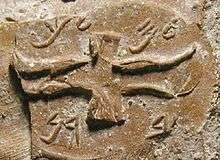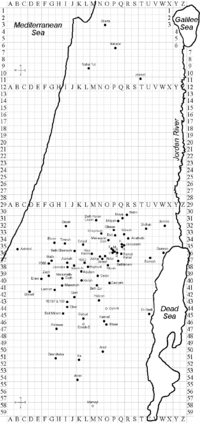LMLK seal
LMLK seals (with LMLK meaning 'of the king') are ancient Hebrew seals stamped on the handles of large storage jars first issued in the reign of King Hezekiah (circa 700 BC) and discovered mostly in and around Jerusalem. Several complete jars were found in situ buried under a destruction layer caused by Sennacherib at Lachish.[1] While none of the original seals have been found, some 2,000 impressions made by at least 21 seal types have been published.[2] The iconography of the two and four winged symbols are representative of royal symbols whose meaning "was tailored in each kingdom to the local religion and ideology".[3]

Text

LMLK stands for the Hebrew letters lamedh mem lamedh kaph (vocalized, lamelekh; Phoenician lāmed mēm lāmed kāp — 𐤋𐤌𐤋𐤊), which can be translated as:
- "[belonging] to the king" (of Judah)
- "[belonging] to King" (name of a person or deity)
- "[belonging] to the government" (of Judah)
- "[to be sent] to the King"
As a prepositional prefix, the lāmed (𐤋) has either a genitive or dative function, and the "to" in each of the above readings can also be read as "for" or "of". The other three letters form the word "melech"; as shown above, its translation can refer to a specific king, to any king, or to the king's government.
A number of jars say "lmlk Ziph", "lmlk Hebron", "lmlk Socoh" and "lmlk mmst" (mmst being a town in the northern hill country). These jars were all manufactured in a single site in the Shepehelah, possibly Lachish, under the authority of the king (alluded to in 1 Chronicles 4:23, thus 'lmlk' means 'belonging to the king'), and from there they were sent to each one of the four administrative region indicated by either the name of the town on the jar (these being Ziph, Hebron, Socoh and MMST).[4]
Sites

Though most of these stamped jar handles have been found in the southern kingdom (71 sites in the ancient territory assigned to the tribes of Judah, Benjamin, and Simeon), some have also been found in the northern kingdom (4 sites in the northwest region). Here is an abbreviated list of the top 20 sites where most specimens have been found through scientific excavations:
| Quantity | Site |
| 415 | Lachish |
| 281 | Jerusalem |
| 163 | Ramat Rahel |
| 92 | Gibeon |
| 88 | Mizpah |
| 71 | Beth Shemesh |
| 39 | Moresheth-Gath |
| 37 | Gezer |
| 24 | Khirbet el-Burj (northwest suburb of modern Jerusalem) |
| 19 | Mareshah |
| 18 | Azekah |
| 15 | Timnah |
| 14 | Gibeah |
| 13 | Tel Erani |
| 13 | Hebron |
| 13 | Sokho (Khirbet Abbad NW of Hebron, not the Sokoh SW of Hebron) |
| 11 | Beth Zur |
| 9 | Arad |
| 8 | Nahal Tut |
| 6 | Gath (city) |
Theories
Beginning with the editio princeps by Charles Warren in 1870, a diverse assortment of theories has been promulgated to explain their function.[5] Since the landmark excavations at Lachish by David Ussishkin during the 1970s,[6] which established the date of the seals to the reign of Hezekiah, the number of feasible explanations has narrowed down to these (all associated with Hezekiah [7]):
- Military rations collected as an emergency during a short period (several months to a few years at most) preceding the Assyrian invasion by Sennacherib
- Government taxes collected throughout the majority of Hezekiah's reign (either 14 or 26 years depending on chronological interpretations) as a long-term economic buildup until the Assyrian invasion by Sennacherib
- Religious tithes collected throughout Hezekiah's 29-year reign in response to his worship reformation following his accession (completely irrespective of the Assyrian invasion by Sennacherib)
In support of the first two theories are the inscriptions, which can be read as the names of four places; in support of the third theory are the geographic statistics, which do not associate any of the four words to a particular place or region other than the entire southern kingdom of Judah. Furthermore, approximately 10–20 percent of the excavated jars and jar handles were stamped.[8]
Depending on which of the above theories are preferred, several other aspects of the operation need interpretation:
- The people who performed the stamping were either government officials working directly for King Hezekiah or Levites and/or priests associated with Solomon's Temple in Jerusalem.
- The icons symbolize either royal stature or a religious nature (Deuteronomy 32:11–12, Ruth 2:12, Psalm 36:7, Psalm 57:1, Psalm 61:4, Psalm 91:4, and Malachi 4:2).[9]
- The super-inscription, LMLK, denotes the Judean government or a specific, divine being (consider its application to the Israelite YHWH as in Psalm 10:16, Isaiah 6:5, and Zechariah 14:9).
- The sub-inscriptions (Hebron, MMST, Socoh, and Ziph) record either 4 places or 4 votive statements.
Engraving styles indicate at least two, possibly five, people made the seals. The 21 types can be grouped together in five or six sets, but they may have been created or utilized in pairs based on quantities of their impressions found so far[10] and internal evidence such as inconsistent use of divider dots.
Researchers frequently use a lowercase "x" as a wildcard character when referring to a series such as x4C instead of using an uppercase "G", "H", "M", "S", or "Z" for the first letter designator. Likewise, an "x" can be used for the second letter designator when referring to all seals with the same word, such as H2x in lieu of H2D, H2T, and H2U.
Thus far, significant quantities of x4C, x4L, and x2U stamps have been excavated from below the destruction layer caused by the Assyrian conquest of Sennacherib, but only a single specimen each of the G2T and M2D stamps (excavated from Jerusalem, which was not destroyed by Sennacherib). This suggests that 12 of the 21 seals were made prior to the attack, and the remaining 9 afterwards. The first significant evidence to support this datum came from the landmark excavations at Timnah led by George L. Kelm and Amihai Mazar.[11]
Personal seals
Several hundred seal impressions made on the same type of jar handle have been found in the same contexts as the LMLK stamps. Over 50 types have been documented, and most of them have a 2-line inscription divided by two somewhat parallel lines. Some have an icon in addition to the inscription; others are strictly anepigraphic (Vaughn 1999).
Incisions
In addition to the seals, which were stamped in the wet clay before being fired in a kiln, certain other marks were incised on these jar handles:
- Concentric circles (usually two—sometimes only one; sometimes applied to unstamped handles but it is uncertain whether they were ever incised on unstamped jars)
- Plus marks (resembling "+" or "t" or "X")
- Hole marks (resembling the central anchor dot of the concentric circles)
- Drag marks (probably attempts to cancel or obliterate the LMLK stamp)
Hundreds of the Circles have been found, but only a few of the Plus, Hole, and Drag marks. Several LMLK stamps may have had additional inscriptions incised over them containing marks resembling the letters "I V" (hence "Ivy incisions"); however, one or more of these handles may just contain stray Drag marks resembling the letters "I V" with no literate semantics intended.
Israeli postage
In 1948, Israel's postal authority chose the Z2U seal design for the first series of postage stamps to include the name of the renascent state. Five multicolored values (3, 5, 10, 20, and 65-mil denominations; Scott catalog numbers 10-4) were printed in sheets of 300 (six panes of 50). Otte Wallish designed the stamps, which have distinctive tabs written in Hebrew declaring: Flying Scroll: "LMLK" Seal Stamped on the Wine and Oil Jugs Given as Tax to the King. Israel released the stamps on September 26, 1948 in time for the October 4 observance of Rosh Hashanah 5709, the Jewish New Year, and thereby inaugurated its annual series of holiday stamps.
Drawings
Types of LMLK seals:
 |  | (reserved for S2T; not known if any existed) |  |  |
| (reserved for H2DR; not known if any existed) | (reserved for M2DR; not known if any existed) |  | (reserved for Z2DR; not known if any existed) | |
 |  |  |  | |
 |  |  |  | |
 |  |  |  | |
 |  | (reserved for S4C; not known if any existed) |  |  |
See also
References
- Ussishkin (2004), The Renewed Archaeological Excavations at Lachish, p. 89 ("As the work of the renewed excavations developed it became clear that the destruction of Level III must be assigned to Sennacherib's attack in 701 BCE.").
- LMLK Research website
- Na'aman, Nadav. "The lmlk seal impressions reconsidered." Tel Aviv 43.1 (2016): 115.
- Naʼaman, Nadav. Ancient Israel and Its Neighbors: Interaction and Counteraction. Vol. 1. Eisenbrauns, 2005, 173-174.
- Grena, LMLK—A Mystery Belonging to the King, 377.
- Published in Ussishkin, "The Renewed Archaeological Excavations at Lachish."
- Hezekiah (whose name means "whom God has strengthened") was king of Judah, the son of Ahaz (2 Kings 18:1; 2 Chronicles 29:1). He reigned twenty-nine years (2 Kings 18:2). Albright has dated his reign to 715–687 BC, while Thiele offers the dates 716–687 BC.
- See Grena, LMLK—A Mystery Belonging to the King, 377.
- As such, the 2-winged icon could represent either the sun as a god, or God as a light, and the 4-winged icon could represent a dung beetle (scarab). The latter symbol was popularized in Egypt and was associated with resurrection/rebirth as well as royal authority.
- Grena, LMLK—A Mystery Belonging to the King, 349
- Mazar and Panitz-Cohen, Timnah (Tel Batash) II.
Bibliography
- Grena, G.M. (2004). LMLK--A Mystery Belonging to the King vol. 1. Redondo Beach, California: 4000 Years of Writing History. ISBN 0-9748786-0-X.
- Grena, G.M. (2006). "Part 1 (Flying Scroll) Digging Deeper into the 1948 Festival Stamps". The Israel Philatelist. 57:3 (June): 100–3. External link in
|journal=(help) - Mazar, Amihai, and Panitz-Cohen, Nava, (eds.) (2001). Timnah (Tel Batash) II, the Finds from the First Millennium BCE, Text. Qedem 42, Monographs of the Institute of Archaeology. Jerusalem, Israel: The Hebrew University.CS1 maint: multiple names: authors list (link) CS1 maint: extra text: authors list (link)
- Ussishkin, David (2004). The Renewed Archaeological Excavations at Lachish (1973 – 1994) Volumes 1 and 4. Tel Aviv, Israel: Institute of Archaeology, Tel Aviv University.
- Vaughn, Andrew G. (1999). Theology, History, and Archaeology in the Chronicler's Account of Hezekiah. Scholars Press; Atlanta, Georgia. ISBN 0-7885-0594-7.
- Warren, Charles (1870). "Phoenician inscription on jar handles". Palestine Exploration Quarterly. 2 (September 30): 372. External link in
|journal=(help)
See also
- Biblical archaeology
- List of artifacts significant to the Bible
- Hebrew alphabet
- Phoenician alphabet